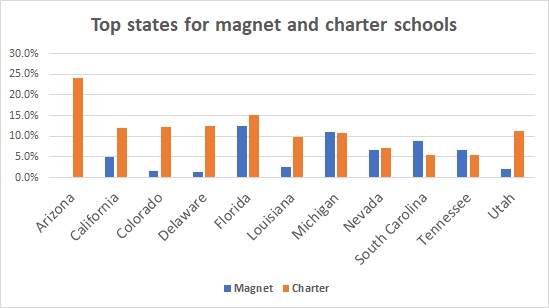Florida remains the leader in public school options, fresh federal data suggest.
The state was home to 653 charter schools and 536 magnet schools during the 2015-16 school year. That means more than 27 percent of the state’s public schools were either magnet or charter. No state had a higher combined percentage of the two options.
Indeed, the Sunshine State has more magnet schools than any other state in the country, both in sheer numbers and as a percentage of public schools.

There may be some quirks in the data tracked by the U.S. Education Department. Previous reports showed Arizona had a handful of magnet schools. This year’s report suggests it has none. But Florida would remain the champ either way.
It’s likely choice begets more choice, as districts expand magnet programs in response to competition from charters.
Arizona does have another form of public school choice — an open-enrollment policy that’s unleashed competition across district lines. Within-district open enrollment is already one of the most widely used forms of school choice in Florida. A new policy expanding public school choice across districts lines, however, has just taken effect this school year.



The right charter, open to the public, should be a magnet for any state wise enough to authorize it. America’s federal government of education should return to its decentralized roots, which are still alive in Canada, for example, where education is constitutionally guaranteed as a matter where the provinces are sovereign. A good state should in turn follow Switzerland’s example and further devolve education to its local districts, only assuring that young adults are mature with either general education for university, specialized education for polytechnical institutions, or vocational maturity for specific careers. A good district like Singapore would in turn take this increased educational power to grant established successful secondary colleges independence, and could grant autonomy to a new school with an appropriate charter in a central region willing to directly subsidize them, which might thereby turn a local planning area into a magnet for citizens throughout such an educationally renewed nation.
If you want to be the choice champion, you’re going to need to get above 50% not attending their zoned school: https://jaypgreene.com/2017/11/17/az-district-open-enrollment-charters-private-choice/
In other words you’ll really be cooking with gas once you get open enrollment fired up!